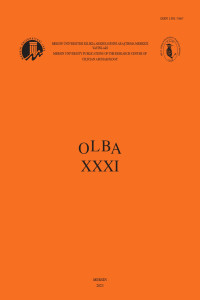Late Antique Period in Cappadocia: Şahinefendi (Sobesos) in the Light of Historical Sources and Archaeological Remains
Öz
The Şahinefendi Village is located within the borders of the Ürgüp district of the Nevşehir
province. The archaeological remains are at the south of the village, close to the springhead of the
Damsa Stream, at a point called “Örencik” by the villagers. Although the Şahinefendi settlement
(Sobesos) exhibits the characteristics of architectural structures and ornamental details encountered
in other parts of the Roman Empire, it can be considered special for this region. There are residences,
bath, religious buildings, and tombs in the settlement. Although the area where the archaeological
remains were found is associated with antique Sobesos, there is no written data to confirm this
identification. Concerning our dating, Sobesos was settled in the 4th century A.D. during its first
phase. The building, which we have dated to the first phase and named Villa I, is located in the south
of the settlement. The two-story building has the features of the upper-class residences of the period.
The building was used as a church during its second phase, and a cemetery began to form around the
building in the same period. In the third and final phase, a single-nave chapel was built in the atrium
of the building. There is another chapel with a courtyard and a single nave, which we call the cemetery
chapel, to the south of Villa I. The remains of the courtyard and structures in the east of the villa
numbered II, which is to the north of the villa I, have survived to date. A row-type bath, widely used
in Late Antiquity, was built in the same period as Villa II. The villa II and the bath were used in later
phases with various changes. Apart from these structures, also new spaces were built in the settlement.
It is not exactly known how long Sobesos was inhabited. Sobesos is seen on the list of dioceses
belonging to the reign of the Byzantine emperor Leon VI, dated to the beginning of the 10th century.
This is the only written record we have about the settlement. The rock-carved courtyard complex,
from the 11th century, the Church of the Forty Martyrs, with its first phase dated to between the 9th
and 10th centuries, the agricultural installations and chapels, all located to the northwest of today’s
archaeological remains, can be considered as the evidence of the nearby socio-economic continuum.
This article aims to discuss how the political, social and religious transformation experienced in Late
Antiquity was reflected in the archeology of a rural settlement in Cappadocia. For this reason, firstly,
the three-phase villa structure in Sobesos is examined in the light of the unpublished archaeological
data I have obtained during my field survey
Anahtar Kelimeler
Cappadocia Late Antiquity Sobesos Imperial Estates Chorepiskopoi.
Late Antique Period in Cappadocia: Şahinefendi (Sobesos) in the Light of Historical Sources and Archaeological Remains.
Öz
The Şahinefendi Village is located within the borders of the Ürgüp district of the Nevşehir
province. The archaeological remains are at the south of the village, close to the springhead of the
Damsa Stream, at a point called “Örencik” by the villagers. Although the Şahinefendi settlement
(Sobesos) exhibits the characteristics of architectural structures and ornamental details encountered
in other parts of the Roman Empire, it can be considered special for this region. There are residences,
bath, religious buildings, and tombs in the settlement. Although the area where the archaeological
remains were found is associated with antique Sobesos, there is no written data to confirm this
identification. Concerning our dating, Sobesos was settled in the 4th century A.D. during its first
phase. The building, which we have dated to the first phase and named Villa I, is located in the south
of the settlement. The two-story building has the features of the upper-class residences of the period.
The building was used as a church during its second phase, and a cemetery began to form around the
building in the same period. In the third and final phase, a single-nave chapel was built in the atrium
of the building. There is another chapel with a courtyard and a single nave, which we call the cemetery
chapel, to the south of Villa I. The remains of the courtyard and structures in the east of the villa
numbered II, which is to the north of the villa I, have survived to date. A row-type bath, widely used
in Late Antiquity, was built in the same period as Villa II. The villa II and the bath were used in later
phases with various changes. Apart from these structures, also new spaces were built in the settlement.
It is not exactly known how long Sobesos was inhabited. Sobesos is seen on the list of dioceses
belonging to the reign of the Byzantine emperor Leon VI, dated to the beginning of the 10th century.
This is the only written record we have about the settlement. The rock-carved courtyard complex,
from the 11th century, the Church of the Forty Martyrs, with its first phase dated to between the 9th
and 10th centuries, the agricultural installations and chapels, all located to the northwest of today’s
archaeological remains, can be considered as the evidence of the nearby socio-economic continuum.
This article aims to discuss how the political, social and religious transformation experienced in Late
Antiquity was reflected in the archeology of a rural settlement in Cappadocia. For this reason, firstly,
the three-phase villa structure in Sobesos is examined in the light of the unpublished archaeological
data I have obtained during my field survey.
Anahtar Kelimeler
Cappadocia Late Antiquity Sobesos Imperial Estates Chorepiskopoi
Ayrıntılar
| Birincil Dil | İngilizce |
|---|---|
| Konular | Arkeoloji |
| Bölüm | Araştırma Makalesi |
| Yazarlar | |
| Yayımlanma Tarihi | 21 Mart 2023 |
| Yayımlandığı Sayı | Yıl 2023 Cilt: XXXI Sayı: XXXI |


